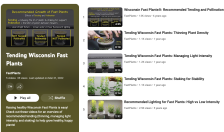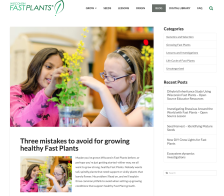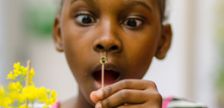Browse Resources
Resources | |
|---|---|
In this set of lessons and Fast Plants experiment, students investigate how plants harness and use different sources of energy during germination and growth. Students ask questions and make predictions about the sources of energy that plants use. They then plan and carry out investigations using...
This activity is designed for teaching the functions of basic plant structures. The activity uses two types of matching cards containing either
a) Structures - depictions of plant structures
b) Functions - descriptions of the function of plant structures
Using the downloadable PDF (including...
This YouTube playlist curated by the Wisconsin Fast Plants Program provides an overview and then demonstrates how to pollinate and harvest seeds from Fast Plants.
This YouTube playlist curated by the Wisconsin Fast Plants Program provides an overview and then demonstrates recommended tending (thinning, managing light intensity, and staking) to help grow healthy, happy plants!
This YouTube playlist curated by the Wisconsin Fast Plants Program provides an overview and then demonstrates planting Fast Plants in three wicking growing systems that are recommended for growing Fast Plants. Two of the recommended systems are built from easily found recycled plastic containers:...
This blog post from the Fast Plants team provides detailed advice and instructions on the ideal timing for harvesting Fast Plants seeds. It is important to harvest at the correct time, to ensure maximum seed viability for planting the next generation. This post addresses several frequently asked...
This blog post by the Fast Plants Team provides a materials list and instructions for a Do-It-Yourself, LED Grow Light that is ideal for Fast Plants growth. This grow light uses cost-effective materials that can be obtained online and from a local hardware store. The light is easy to construct,...
This blog post on the Fast Plants website shares content from podcaster, Matt Candeias, host of the In Defense of Plants podcast. In an interview with Mary Williams of the American Society of Plant Biologists, Matt discusses the important connection fostered between physical experiences and...
This blog post shared on the Wisconsin Fast Plants website is a guest post by Daniel Murphy, author of the weekly blog Awkward Botany. In this post, Daniel shares his firsthand account of his experiences growing plants and becoming "a bona fide plant nerd." This post is a great example of the value...
This blog post from the Wisconsin Fast Plants website is a guest post by classroom teacher, Julie LaConte, of Rossman School in Creve Coeur, MO. In this post, Julie describes her experiences researching, preparing for, and teaching with Fast Plants in her classroom. Thank you for sharing your...
This blog post from the Wisconsin Fast Plants website describes the value of using Fast Plants as a model organism for biological and environmental investigations. This post is primarily an index of Fast Plants resources, providing prompts for teaching goals and suggesting Fast Plants kits...
This blog post from the Fast Plants Team addresses the question "Do Fast Plants need Vernalization to Flower?". This post describes the concept of vernalization (requiring a cold period to induce flowering) and its role in regulating the development of flower structures in flowering plants. Some...
This blog post from the Wisconsin Fast Plants Team describes three ways to optimize your growing environment to grow healthy Fast Plants.
Tips for growing healthy plants are focused around the following three concepts, with descriptions of ideal environmental conditions for each:
1. Not enough...
This blog post from the Wisconsin Fast Plants website provides an overview and list of resources for teaching about observable variation and measuring selection (focusing on leaf hairs/trichomes). This blog is primarily a point of reference for other Fast Plants teaching resources.
This blog post from the Wisconsin Fast Plants website provides an overview and list of resources for teaching about heredity and inheritance patterns with Fast Plants seed varieties. This blog is primarily a point of reference for other Fast Plants teaching resources, but includes specific detail...
This blog post from the Wisconsin Fast Plants website provides an overview and list of resources for teaching life science topics with Wisconsin Fast Plants. This blog is primarily a point of reference for other Fast Plants teaching resources.
This 5-page handout aims to help students and their adult mentors explore topics and questions about the natural world and/or Fast Plants growth and development that could be investigated through research and experimentation. The handout is intended to inspire scientific question development that...
This blog post from the Fast Plants Team addresses the question "Are Wisconsin Fast Plants Genetically Engineered Plants?". This post describes the origins of Fast Plants (they are the result of conventional plant breeding, not genetic engineering), defines terms related to plant breeding and...
This blog post from the Wisconsin Fast Plants website describes the observation of plant hairs (trichomes) for conducting a selective breeding experiment (such as in AP Biology investigations). The number of hairs is variable in Fast Plants seed varieties, and selection for or against plant...
This blog post from the Wisconsin Fast Plants website describes the value of using Fast Plants as a model organism to teach plant life cycles at multiple grade levels. Content includes an overview of plant growth stages (including videos) and links to resources and activities that can enrich...
This blog post from the Fast Plants team addresses the question "can bee sticks sting?" (no, bee sticks cannot sting) and provides information on the use of bee sticks for pollination of Fast Plants in the classroom.
This is a page on the Fast Plants website, describing the Confetti Seed Mix variety of Wisconsin Fast Plants (Brassica rapa). Confetti Mix includes phenotypes from several Fast Plants varieties, including purple stem, non-purple stem, yellow-green leaf, rosette-dwarf, tall plant, petite, variegated,...
This investigation begins with a phenomenon that is evidenced in most every produce aisle: Many of the vegetables that botanists classify as Brassica look and taste different. This investigation aligns with middle and high school Next Generation Science Standards as well as with agricultural science...
This blog post, written by Joel Cryer of Bottle Biology, provides instructions to construct an inexpensive, self-watering planter that can be used to grow Wisconsin Fast Plants. The blog covers the materials and tools needed, as well as step-by-step instructions to create a universal reservoir...
This video is provided by Wisconsin Fast Plants, and introduces three recommended planting systems to use for planting Fast Plants seeds. The video gives an overview of the different methods: the Deli Container, the Wisconsin Fast Plants Watering System, and the Bottle Growing System. This recording...
This video is provided by Wisconsin Fast Plants and demonstrates how to plant Fast Plants seeds using the Deli Container Growing System. The video gives an overview of the materials necessary to grow plants with this method, and also provides step-by-step instructions guiding the process. This...
This video is provided by Wisconsin Fast Plants and demonstrates how to plant Fast Plants seeds using the Bottle Growing System. The video gives an overview of the materials necessary to grow with this method, and also provides step-by-step instructions guiding the process. This recording runs for...
Part of the Fast Plants website, the "Grow" section offers complete instructions for preparing to grow, planting, tending, pollinating, and harvesting Wisconsin Fast Plants seeds. Instructions include text descriptions, photos, videos, and PDF instructions that can be downloaded, including a...
Read this blog post for background information about the relationship between the biological environment and life processes and systems in Fast Plants.
Growing healthy Fast Plants is easy if you understand how the environment can affect growth and development. Three broad categories of...
Read this blog post for background information about the relationship between the chemical environment and life processes and systems in Fast Plants. Growing healthy Fast Plants is easy if you understand how the environment can affect growth and development. Three broad categories of environmental...
Read this blog post for background information about the relationship between the physical environment and life processes and systems in Fast Plants.
Growing healthy Fast Plants is easy if you understand how the environment can affect growth and development. Three broad categories of environmental...
Who knew that rocket science could have so much in common with botany and plant pathology? This is a human interest and science story that documents from firsthand accounts and artifacts the historical context and scientific events relevant to an important collaborative Fast Plant investigation on...
Illustrated instructions for constructing and planting seed disks in the Fast Plants deli-container growing system. This is a stable growing system that is easy to construct for all age learners, and works well for growing Wisconsin Fast Plants. Made from recycled deli-containers, these growing...
This 2-page handout gives instructions for making the seed sponge model that was developed by the Wisconsin Fast Plants Program as a tool for learning about germination. Visualizing what is inside a seed and how those structures function during germination is modeled, using a simple kitchen sponge....
This is "The Story of Fast Plants" - a short story of the origins of Brassicas and the work of Dr. Paul Williams, developing Brassica rapa. Reading level ~7th grade.
This is a jpg version of the Wisconsin Fast Plants life cycle that is found on our website. These Fast Plant illustrations were drawn by Alison Schroeer.
These instructions describe how to construct a plant light box from two stackable plastic file crates that are cut, lined with aluminum foil and lit with a 40/42-watt CFL bulb. This 3-page document includes a complete materials list and 12-step assembly instructions with photographs that illustrate...
Illustrated instructions for constructing and planting in the Fast Plants deli-container growing system. This is a stable growing system that is easy to construct for all age learners, and works well for growing Wisconsin Fast Plants. Made from recycled deli-containers, these growing systems can be...
This pdf includes background information and an activity for engaging students in the processes that occur during pollination, fertilization and seed development in Fast Plants. Pollination is explained and illustrated and an activity for students to pollinate Fast Plants and observe reproductive...
This webpage from the Fast Plants website explains how to pollinate Fast Plants, including instructions for making bee sticks and pollination videos and tips.
Download and print this colorful "Science Inquiry Map" Poster featuring the web of inquiry processes as described by the Five Essential Features of Inquiry from the National Science Education Standards. In addition, the model of inquiry described by the Five Essential Features aligns directly with...
An article written for children, this reading explains the role of plants as producers. It is written at a grade 4-5 reading level, and it is a good supplement to the evidence that students can observe and record through experimentation with photosynthesis.
This Immersion Unit provides a coherent series of lessons designed to guide students in developing deep conceptual understanding that is aligned with the standards, key science concepts, and essential features of classroom inquiry (as defined by the National Science Education Standards).
Unit...
This Immersion Unit provides a coherent series of lessons designed to guide students in developing deep conceptual understanding that is aligned with the National standards, key science concepts, and essential features of classroom inquiry (as defined by the National Science Education Standards)....
Download this complete and coherently designed, middle school level unit to teach fundamental concepts that underpin the theory of evolution. The unit was collaboratively designed by teachers, college faculty & staff, and the Fast Plants Program at UW-Madison to support student-centered...
A 32-page booklet, containing complete instructions for activities at each life cycle stage. The booklet also includes important background information about plant physiology and how to grow Fast Plants. A Growth, Development and Reproduction kit is available. You can also conduct all the...
This is a page on the Fast Plants website, describing the Standard variety of Wisconsin Fast Plants (Brassica rapa). This page includes suggestions for investigations and teaching applications using this seed variety, including use as a model organism to teach about the plant life cycle and plant...
Description: In this activity students become acquainted with the anatomy and biology of seeds. They will use lenses and scales and make drawings to scale. Students will measure and calculate magnifications and they will begin to understand relationships among these. They will organize and summarize...
A 23-page PDF file (644 KB) with a complete set of activities for elementary students (also effective in middle school) to learn about the life cycle of flowering plants with a focus on reproduction. Students predict how many seeds their Fast Plant will produce and engage in planting, growing,...
| |
















































